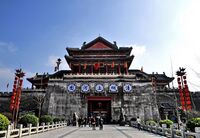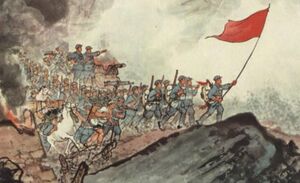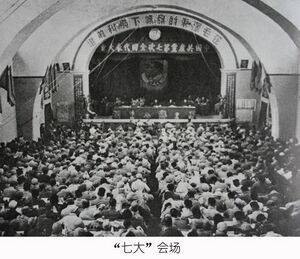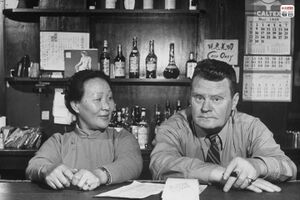Yanbad
This article is incomplete because it is pending further input from participants, or it is a work-in-progress by one author. Please comment on this article's talk page to share your input, comments and questions. Note: To contribute to this article, you may need to seek help from the author(s) of this page. |
The People's Republic of Yanbad | |
|---|---|
| Motto: Dare to think, dare to act, dare to speak | |
| Anthem: 国际华人合唱团 The Internationale | |
| Capital | Ganzhu |
| Official languages | Standard Chinese |
| Recognised regional languages | Mongolian,Vietnamese |
| Ethnic groups (2017) | 85.0% Han 5.0% Kinh 3.0% Manchu 2.0% Mongol 1.0% Jingpo 1.0% Kadai 1.0% Phu La 1.0%Yao 1.0% Zhuang |
| Demonym(s) | Yanbadi |
| Government | Unitary one - party socialist republic |
• Prime Minister | Yi Qianfeng |
• Party Leader | Enter Name |
• Congress Head Chair | Enter Name |
| Legislature | National People's Congress |
| work in progress | |
| Area | |
• Total | [convert: invalid number] |
• Water (%) | work in progress |
| Population | |
• wip estimate | wip |
• Density | [convert: invalid number] |
| GDP (PPP) | wip estimate |
• Total | wip |
• Per capita | wip |
| HDI | 0.949 very high |
| Currency | Yanbadi Baht (YAB) |
| Time zone | UTC+0 (wip) |
• Summer (DST) | UTC+1 (Observed) |
| Date format | dd-mm-yyyy |
| Driving side | the right |
| Calling code | +611 |
| ISO 3166 code | YAN |
| Internet TLD | .yan |
The People's Republic of Yanbad, commonly referred to as just Yanbad , is an unitary one-party socialist republic in Eastern Ophion. It is a medium-sized country with a population of around 100 million people, all of which live in the country's nine provinces. Yanbad borders Akina to the north, The Dictatorship POD to the west , and Donghai Rongguo to the south.
Etymology
Historians believe that the region came to be known as "Yanbad" due to a translation mistake of the first dynasty's name which was Yan.
Demographics
Language
Yanbad's national language is Standard Chinese. Schools nationwide teach the language and use it for instructions. The Standard Chinese language is the lingua franca for the People's Republic and is spoken throughout the country. Although in different regions there are different dialects of the language. In the Southern provinces of Yanbad where the Kinh, Phu La, and the Jingpo people predominately live the Vietnamese language is often used in place of Standard Chinese. Whereas the Mongolian language is spoken in the Northern provinces where the Mongolian people live.
Religion
Freedom of religion is officially provided for in the Constitution of the People's Republic of Yanbad. The government does not interfere with any religious beliefs or lack of, but is generally irreligious. Many Yanbadi citizens define themselves as non-religious or atheist , although there are many religious minorities throughout the country who are allowed to express their religion freely.
Health
Healthcare in Yanbad consists of both public and private health insurance. Approximately 90% of Yanbadi citizens have at least basic health insurance due in part to the benefits workers enjoy through the Iron Basket Initiative that the Communist Party of Yanbad's Politburo Standing Committee enacted after the formation of the People's Republic.
Education
History
Prehistoric Yanbad
Historians and scholars refer to Prehistoric Yanbad as the era of The Five Sovereigns and Ten Emperors. Much isn’t known of this time period since there is a lack of primary sources written during the time period. Scholars throughout the subsequent dynasties had written about this time period and referenced them in their own documents. As a result all of the written accounts related to this era are questionable at best. Most of the knowledge from this time period was discovered via archaeological digs and studies of material culture. The leading consensus is that Prehistoric Yanbadis buried their dead with supplies for the afterlife. Items such as food, weapons, clothing, and pottery have been discovered in many ancient tombs.
Background on Different Dynastic Eras
One might assume that throughout the Imperial Era the various dynasties all rose and fell through violent means. While there are instances of a dynasty violently overthrowing another there are also examples of dynasties taking control through more peaceful means such as one family dying out.
Yan Yanbad
The Yan Dynasty ruled over modern day eastern Yanbad from 230 BCE to 200 BCE. It was the first dynasty of Imperial Yanbad and the first to unify the eastern heartland of Modern Yanbad. The founder of the dynasty Yan Bao unified the empire in 230 BCE and ruled it until his death in 222 BCE. Yan Guang (230 BCE - 209 BCE) ruled over the empire and finished his father's work of building the capital of Ziyang and the palace of Hengdai. The last Yan Emperor, Yan Ang (209 BCE - 200 BCE) died without an heir which caused the throne to pass to the Tay family which were related to the Yan through marriage. Historians believe that the region came to be known as "Yanbad" due to a translation mistake of the first dynasty's name.
Tay Yanbad
Hong Yanbad
The Hong Dynasty took control of Yanbad after their victory in the War for the Rivers
Lui Yanbad
Taizong Yanbad
Zhu Yanbad
Kaidu Yanbad
Hongwu Yanbad
Fulen Yanbad
Decline of the Imperial System
The People's Republic of Yanbad
World Wars
Cold War
Modern era
Geography
Climate
Administrative divisions
The People's Republic of Yanbad is divided in to nine provinces, each of which is divided in to a varying number of administrative counties.
Politics
The Communist Party of Yanbad
The Communist Party of Yanbad was founded after the Communist Manifesto had been translated into Standard Chinese and spread among educated youth in the treaty ports throughout Yanbad's coastline.
The current leader of the Communist Party of Yanbad is Prime Minister Yi Qianfeng
National People's Congress
Communist Party of Yanbad's Politburo Standing Committee
The Politburo Standing Committee serves as a cabinet for the Prime Minister. Members are appointed by the Prime Minister and symbolically voted in by the National People's Congress. The newest position, Secretary of Youth Engagement was created on October 14, 2019 via executive directive and Ai Naal was appointed for the position.
Local politics
Foreign relations
Following the successful Communist Revolution in Yanbad relations with Donghai Rongguo broke down entirely. Fearing a capitalist intervention from Donghai, the Communist Party of Yanbad established a Demilitarized Zone on its southern border.
Military
Economy
Transport and infrastructure
Energy
Culture
National Animal
The national animal of the People's Republic of Yanbad is the Leatherback Sea Turtle due in part to the Hong family's victory over the Tay at the Soupi Bend during the Wars of the Rivers. The Wars of the Rivers were a series of conflicts between supporters of the Hong and supporters of the Tay over control of Yanbad. During the initial phase of the conflict Hong forces were steadily pushed from their homeland in the interior to the coast by Tay forces. The reason for the Tay's success was in large part due to their superior naval forces which dominated the rivers throughout Yanbad. After a long retreat to the coast the leader of the Hong forces, Hong Anh Son, could not help but notice the Leatherback Sea Turtles along the shore. According to historian Qui Phuc the "unique shape of the turtles" inspired Hong Anh Son to issue orders for the creation of what he called the Turtle Boat and with it a daring attack plan to seize back the initiative.
Fortunately for Hong Anh Son, the Tay forces had over extended their supply lines and had to rest. The location they decided to rest at was the Soupi Bend, which was easily defensible from land attacks but was surrounded by water on three sides. To remedy this weakness to waterborne attacks, the Tay anchored their river boats off the coast of the bend. The Tay forces decided to rest for a few weeks in order to prepare for the final battle to push the Hong into the sea. The Tay decision to rest gave the Hong a much needed respite and more importantly time to craft the turtle boats. Hong Anh Son's scouts reported the Tay location to him and decided to divide his forces into two parts. The first group would utilize the new turtle boats and attack the Tay boats. The second group was ordered to attack the Tay positions defending the Soupi Bend. According to Qui Phuc, Hong issued the order to attack "when the moon was absent from the sky."
Phuc's described the battle as a "tremendous route of the Tay forces, they were completely surprised by the dual attack led by Hong Anh Son on land and the turtle boats on the river." The initial plan called for the land forces to attack first then have the turtle boats attack the Tay boats when the battle started. Fortunately the turtle boats reached the Tay ships before the land forces,completely unknown to Hong Anh Son. Phuc claimed "that the Tay boat crews mistook the turtle boats for actual turtles," as a result they ignored them until the fires started. The blaze that broke out throughout the Tay boats caused panic throughout their camp but more importantly was a sign for Hong Anh Son to change his tactics and attack the camp with the remainder of his forces.
The battle was a complete victory for the Hong who were able to seize the initiative from the battle to defeat the Tay forces and consolidate their rule over Yanbad. When Hong Anh Son took the throne of Yanbad after the war, he was called the Turtle King by his admirers. As a way to honor the animal that inspired his success, Hong Anh Son decreed that any harm done to animal was "punishable by death." Even after the revolution that overthrew the royal family Hong Anh Son's decree stayed in effect due in part to Communist officials seeing the Hong family as "proto - proletariat" who were being abused by the bourgeoisie Tay.
Art
Philosophy and literature
Literature
One of the biggest book series in Yanbad is the Ballad of the Rivers which is a high fantasy series that was inspired by the Wars of the Rivers that were fought between Tay and Hong families. The books have spawned multiple spin-offs, video games, and even an award winning show! The television adaption of the series is named after the first book, A Frolic of Rivers.
A Frolic of Rivers - Japanese.asoiaf.arya.full (2).jpg The first book in the main series shocked fantasy fans with the unexpected execution of the Li family patriarch Li Hed, by Zhang Jo. The execution ignited the conflict between the Zhang and Li families, thus dragging all of the powerful families of Yessos into a dynastic conflict for the Rama Throne.
Disharmony of Ramas - The second book continues the conflict between the Li and Zhang but expands the characters involved beyond the two major families. With multiple claimants as the “True Rama” war erupts throughout the kingdom, all while an ancient claimant to the throne gathers strength in the east, Tasa Dane.
Monsoon of Glaives - The third and final book details the climactic battle between the Li and Zhang. One of the main characters Li Jen who is thought to be an illegitimate bastard of Li Hed is revealed to be the actual heir to the Rama Throne since he is the eldest living male heir of the Tasa family.
Architecture
Media
| Logo | Television channel | Public / Private | Description | Audience share |
|---|---|---|---|---|

|
People's Republic of Yanbad News (PRYN) | Public | news, state programming | |
| [[File:|50px]] | ||||
| [[File:|50px]] | ||||
| [[File:|50px]] | ||||




